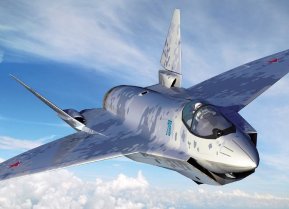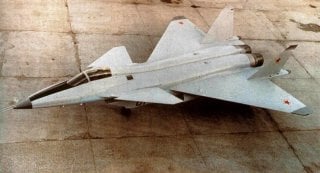MiG 1.44: Russia Tried To Build Their Own F-22 Raptor Stealth Fighter
The MiG 1.44 finally made its maiden flight in February 2000, just nine years behind schedule, with test pilot Vladimir Gorboonov in the cockpit. During the 18-minute flight, the 1.44 reached a maximum height of 1,000 m (3,300 ft) and reached speeds of 600 km/h (370 mph).
MiG 1.44: Russia Tried to Build Its Own F-22 – It Failed - By the end of the Cold War, the Soviet Union was much more reactionary than its idealistic founders likely could have foreseen. Not only did some of its late-era reforms embrace some Western concepts, but its military had largely fallen behind in developing weapons that were superior to those of its NATO counterparts.
This was certainly true of aircraft.
After learning of the American "Advanced Tactical Fighter" program, which would eventually lead to the production of the Lockheed Martin F-22 Raptor air superiority fighter, the Soviets responded with its own "Multifunctional Frontline Fighter." The ATF would eventually go on to be the project that saw the creation of one of the best fighter jets of all time according to many experts, while the MFF is largely forgotten.
The Mikoyan Project 1.44/1.42
The Soviet efforts began in the 1980s to replace the successful Sukhoi Su-27 (NATO reporting name "Flanker") and to keep pace with the U.S. Air Force.
To confuse matters, the program, which began at the Mikoyan Design Bureau, was named the 1.42. It signified the project and its prototype aircraft – while the 1.44 designated the program's aerodynamic test airframe, of which two are believed to have been produced. NATO eventually assigned the reporting name "Foxglove" to the 1.42, while the 1.44 was dubbed "Flatpack."
The MiG 1.44 would incorporate many fifth-generation jet fighter aspects, including advanced avionics, stealth technology, supermaneuverability, and supercruise.
Of course, it followed a familiar trend with late-Cold War-era Kremlin projects, and it was delayed due to cost issues. U.S. President Ronald Reagan had started a costly arms race, and it was one the Soviets had no hope of winning.
Yet, credit could be given to Moscow for even trying to develop such an advanced aircraft.
No F-22: Numerous Issues With the MiG 1.44/1.42
The Project 1.44/1.42 was such an effort that likely seemed good on paper, but it faced numerous and lengthy postponements due to a chronic lack of funds. It was reported to be a cutting-edge aircraft that was to have made use of an internal weapons bay – although the demonstrator that was eventually showcased utilized external weapons pylons. The estimated performance included a top speed of around Mach 2.6 or roughly 1,716 mph.

The delta wing, twin-tailed aircraft featured a close-coupled canard layout which, when working with the thrust vectoring engine nozzles, gave the aircraft remarkable maneuverability – while it was controlled by a fly-by-wire flight control system. It utilized a tricycle landing gear system, with a single, dual-wheel landing gear in the front, and two single wheels in the rear.
It is reported to have been manufactured of aluminum-lithium alloys, as well as steel and titanium alloys.
Stops and Starts
The project was put on hold following the dissolution of the Soviet Union and the end of the Cold War. But Moscow did press on, and taxi trails were completed in 1994 at the Zhukosky Airfield.
Even as the program began to make progress, it was postponed due to lack of funding, and in 1997, it was canceled due to a high per-unit cost. Yet, the efforts found new life, briefly.
All But Forgotten
As a largely failed design, it isn't surprising that except for military aviation buffs, few have even heard of this aircraft. Yet, it should be noted that the program was classified by the Russian Defense Ministry until it was finally publicly unveiled in January 1999.
It was briefly revived for a final time.
The MiG 1.44 finally made its maiden flight in February 2000, just nine years behind schedule, with test pilot Vladimir Gorboonov in the cockpit. During the 18-minute flight, the 1.44 reached a maximum height of 1,000 m (3,300 ft) and reached speeds of 600 km/h (370 mph).
A second flight in April of the same year, lasting 22 minutes, uncovered a number of previously unknown problems with the prototype. As a result, there were no further tests, and the program was canceled for good.
The sole prototype known to still exist currently resides at Gromov Flight Research Institute – it was restored/refurbished and was displayed at the MAKS 2015 air show outside of Moscow.
The Legacy of the MiG 1.42/1.44
After the cancelation of the program, the Russian Air Force officially selected a new Sukhoi PAK FA, which was later redesignated as the Su-57, as its new fighter.
However, it has been noted that the Chinese J-20 aircraft has a similar configuration to the MiG 1.42/1.44, notably the canards, tail section, and "duck-like" aerodynamic design.
This has led to speculation that the development of the Chinese Chengdu J-20 "Mighty Dragon" was assisted by the MiG aviation company – or that it drew heavy inspiration. Of course, it is also widely believed that Beijing developed the J-20 using technology acquired from the F-22 Raptor. The J-20 fighter was officially adopted in 2017, and it could be the final legacy of the Soviet Union's failed fighter design.
Author Experience and Expertise
A Senior Editor for 19FortyFive, Peter Suciu is a Michigan-based writer. He has contributed to more than four dozen magazines, newspapers, and websites with over 3,200 published pieces over a twenty-year career in journalism. He regularly writes about military hardware, firearms history, cybersecurity, politics, and international affairs. Peter is also a Contributing Writer for Forbes and Clearance Jobs. You can follow him on Twitter: @PeterSuciu.


